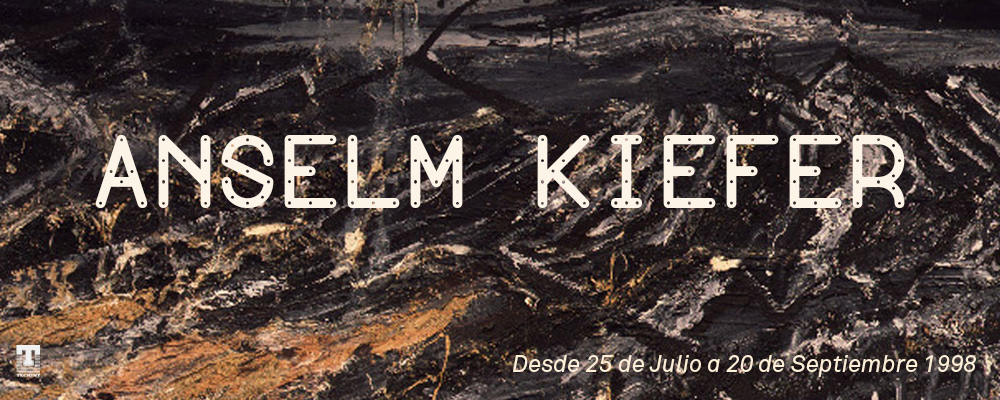Anselm Kiefer
Auspicia: Fundación Proa
Curator: Robert Littman
Sponsor: Siat - Siderca - Tamsa - Organización Techint - Goethe Institut Buenos Aires
25 de Julio a 20 Septiembre 1998
--
The knowledge of Kiefer's works in our country dates back to the early '80, through the specialized art magazines. A little belatedly compared to his international recognition, it is in this exhibition that we are able to contemplate his work for the first time in Argentina.
During this stage, Kiefer reflects on the history and its myths, focusing his themes in the German tradition. As soon as the Wall was pulled down, he leaves Germany and settles in the South of France, in Barjac. During that time, he travels to India, Mexico, and new works appear stemming from the knowledge of other icons, no longer based on regionalism but in old and universal facts such as: the pyramids, the Cabala, nature, etc.
His works on the pyramids, (Mexico, 1996) seem to be "built", in the way of the pre-Columbian cultures, using the same method. The matter is used as a brick, with the same imperfection and craft. Faced to this new-world icon, Kiefer carries out a series of works titled "I Bring all the Indians in my hand", sentence taken from one of Quevedo's poem and that represents very well the idea of how the new world was conceived in the fifteen-century Europe. In these works there appears a man who, as a magician, holds all the continents, all the Indies in his hands. It represents the Eurocentrist vision of the time of the conquest by which the European man - center of the world - has in his hands all the power he calls India.
It is by the usage of icons teeming with history that the artist demands the viewer to reflect on the different possibilities in connection to an event, and not to arrive to a sole definite opinion.
The exhibition we show today, in charge of Robert Littman, is a group of works that presents different themes and moments of Kiefer's work, as well as the various disciplines used by the artist. It includes paintings, leads, xylographs, engravings, pictures and his famous books.
"Et la terre tremble encore" 1982, is one of his several devastated landscapes. The artist's knowledge of the Cabala can be seen in the several versions that we exhibit titled "Die Sefiroth." For the Cabalists, "Sefiroth" means the indivisible unit where the cosmic presence and universal energy is concentrated. The man of Renaissance knowledge, who knew about alchemy and Cabala, and who approaches the science is represented in the work "Robert Fludd", 1996. In "The fathers of the Universal Wisdom", 1993, introduces the portraits of men interwoven by a spider's web that gathers them further in a historical time. Here the artist selected the most popular images among his figures and joined them on a great cloth.
The genealogical trees, built on the basis of their contribute and likeness rather than on their relationship ties are present in "The Queens from France". A succession in time that begins around the IV century and that will be completed in the XXII century. Kiefer recognizes his last queen by the middle of the XIX century.
An idea that goes and develops can be observed through the pages of his books. For instance, in "L ' Auvergne", nature goes from animals to the infinite image of the stars. The book-catalog we present is based on the idea of presenting the vast panorama of his work. The main article - written by Andreas Huyssen - is a reflection on the history of the images in Kiefer's work that covers the artist's plastic panorama up to l992.
Gabriela Massuh describes the context of the intellectuals and artists born in Germany during the end of the war. The different aspects of how the creators faced their terrible history and the treatment given to it.
This exhibition was accomplished thank to the contribution of many people,especially to Anselm Kiefer who lent his works, to Robert Littman curator of the exhibition who paved the way for its realization; to the Goethe Institut of Buenos Aires, and to Siat, Siderca and Tamsa, companies belonging to the Techint Group who gave their unconditional support to this project.The knowledge of Kiefer's works in our country dates back to the early '80, through the specialized art magazines. A little belatedly compared to his international recognition, it is in this exhibition that we are able to contemplate his work for the first time in Argentina.
On the part of the young Argentinean artists of the eighties, it is not of influence but of admiration that we speak. The recognition was not only due to the virtuosity of his work but to the audacity in the treatment of the themes. In those times, Argentina went through one of its most critical and difficult times, and the artists faced the hardship and bore the weight of such horror. In those times, Kiefer appears with a very strong imprint in the local environment, more than any of his colleagues, and his works were confronted with those of the Italian artists of the trans-vanguard - works full of irony and luxurious style. Kiefer's early works outline - quoting Andreas Huyssen's words in the main text of this catalog - "the fear of history". Although we know that images don't have an ideology, Kiefer chooses those that bear their own historical weight, appearing inquiring and violent to the viewer. Whether devastated landscapes, big architectural spaces of power or human expressions - like the one in "Occupations" -, Kiefer faces us with the problem of how and why certain images acquire "moral" value.
During this stage, Kiefer reflects on the history and its myths, focusing his themes in the German tradition. As soon as the Wall was pulled down, he leaves Germany and settles in the South of France, in Barjac. During that time, he travels to India, Mexico, and new works appear stemming from the knowledge of other icons, no longer based on regionalism but in old and universal facts such as: the pyramids, the Cabala, nature, etc.
His works on the pyramids, (Mexico, 1996) seem to be "built", in the way of the pre-Columbian cultures, using the same method. The matter is used as a brick, with the same imperfection and craft. Faced to this new-world icon, Kiefer carries out a series of works titled "I Bring all the Indians in my hand", sentence taken from one of Quevedo's poem and that represents very well the idea of how the new world was conceived in the fifteen-century Europe. In these works there appears a man who, as a magician, holds all the continents, all the Indies in his hands. It represents the Eurocentrist vision of the time of the conquest by which the European man - center of the world - has in his hands all the power he calls India.
It is by the usage of icons teeming with history that the artist demands the viewer to reflect on the different possibilities in connection to an event, and not to arrive to a sole definite opinion.
The exhibition we show today, in charge of Robert Littman, is a group of works that presents different themes and moments of Kiefer's work, as well as the various disciplines used by the artist. It includes paintings, leads, xylographs, engravings, pictures and his famous books.
"Et la terre tremble encore" 1982, is one of his several devastated landscapes. The artist's knowledge of the Cabala can be seen in the several versions that we exhibit titled "Die Sefiroth." For the Cabalists, "Sefiroth" means the indivisible unit where the cosmic presence and universal energy is concentrated. The man of Renaissance knowledge, who knew about alchemy and Cabala, and who approaches the science is represented in the work "Robert Fludd", 1996. In "The fathers of the Universal Wisdom", 1993, introduces the portraits of men interwoven by a spider's web that gathers them further in a historical time. Here the artist selected the most popular images among his figures and joined them on a great cloth.
The genealogical trees, built on the basis of their contribute and likeness rather than on their relationship ties are present in "The Queens from France". A succession in time that begins around the IV century and that will be completed in the XXII century. Kiefer recognizes his last queen by the middle of the XIX century.
An idea that goes and develops can be observed through the pages of his books. For instance, in "L ' Auvergne", nature goes from animals to the infinite image of the stars. The book-catalog we present is based on the idea of presenting the vast panorama of his work. The main article - written by Andreas Huyssen - is a reflection on the history of the images in Kiefer's work that covers the artist's plastic panorama up to l992.
Gabriela Massuh describes the context of the intellectuals and artists born in Germany during the end of the war. The different aspects of how the creators faced their terrible history and the treatment given to it.
This exhibition was accomplished thank to the contribution of many people,especially to Anselm Kiefer who lent his works, to Robert Littman curator of the exhibition who paved the way for its realization; to the Goethe Institut of Buenos Aires, and to Siat, Siderca and Tamsa, companies belonging to the Techint Group who gave their unconditional support to this project.
Organization
Fundación Proa
Curator
Robert Littman
Production and Assembly
Sergio Avello
Research Merit
Fernando Bruno
Didactics of the sample
Hugo Petruschansky
Texts
Andrea Huyssen
Gabriela Massuh
Translation
A. De Lorenzini
Photos in color
Gustavo Sosa Pinilla
Design
Dto. de Diseño Fundación Proa
Willy Goldshmidt
Gratitude
Museo de Arte moderno de Sao Pulo
Rubén Cherñajovsky y Sra.
Sra. Rejane Cintrao
Sponsors
Siat
Siderca
Tamsa
Organización Techint

